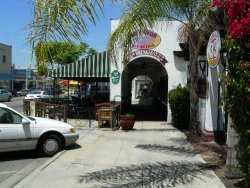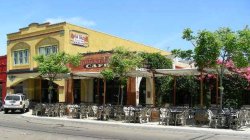Road Diet
El Cajon, California
Prepared by Ryan Snyder, Ryan Snyder Associates.
El Cajon, California
Prepared by Ryan Snyder, Ryan Snyder Associates.
Suburban development and increased traffic diminished Main Street's appeal to pedestrians, leading to empty storefronts and a failing historic downtown.
Downtown El Cajon is the historic heart of east San Diego County. It blends unique architecture and character, yet it struggles with a problem afflicting the urban core of many American cities: competition from suburban shopping areas. By the 1980s Main Street was lackluster and quiet. When shoppers came, they found many empty storefronts and few reasons to return. El Cajon also lacked a pedestrian-oriented district where people could stroll, shop, and dine. Traffic had increased on the four-lane main street, making the area more of a pass-through place than a destination. Main Street's decline meant lost sales tax revenue for the city.
In 1971 the Redevelopment Agency was formed. In 1999 El Cajon passed a new implementation plan for a downtown revitalization effort, and has been actively pursuing new projects since. The city approached revitalization with a variety of strategies. One of these has been a "road diet" of East Main Street for a four-block area. This section previously had four travel lanes and on-street parking. The city reduced the street to two travel lanes and added angled parking. This reconfiguration slowed traffic and widened sidewalks to make walking safe and inviting and create public space for outdoor dining, landscaping, street furniture, and curb extensions/bulb-outs at intersections.


Thanks to the East Main Street road diet, wider sidewalks and the amenities they make possible have created an inviting pedestrian environment in historic El Cajon. Photos: Ryan Snyder.
Along with East Main Street's road diet, the city adopted a land use plan to add significant new housing units, offices, and retail. Development guidelines for downtown ensure that new development occurs with an urban form that supports walking. The city also enhanced nearby pedestrian walkways to connect to East Main Street. The Community Development Corporation sponsors events to attract people. These events and the new pedestrian-friendly streetscape bring more life to the street.
Downtown El Cajon is in the midst of its revitalization effort. The city has allocated $32,915,000 for capital improvement projects in downtown over the next five years. Higher-density housing is under construction and other new development will come soon. As the city's new development guidelines bring denser housing and mixed land uses, El Cajon will have more people within walking distance of retail, civic, and office uses. These new uses attract more shoppers to support the growing retail establishments on East Main Street.
Times are better in downtown El Cajon. The road diet is one factor that has contributed to the economic vitality demonstrated in the following statistics.
Since 1996, property values have increased by 181 percent compared to 75 percent in the city at large, taxable sales in downtown have increased by 66 percent compared to 45 percent in the city at large, revenue from the Transient Occupancy Tax (hotel tax) has increased by 36 percent, lease rates have increased by 56 percent, and crime has decreased by 16 percent. Since 1998, the private sector has invested $43,175,000 in downtown. Since 2001, 179 new businesses have opened and 746 new jobs have been created. Today, 91 percent more customers shop and dine in downtown than did in 2002.
As the downtown revitalization effort continues, El Cajon looks forward to a cycle of more investment, more business openings, and more tax revenue. All this will continue to transform downtown El Cajon into a lively pedestrian environment where people safely work, shop, dine, entertain, and attend cultural events.
A fact sheet on "The Economic Benefits of Walkable Communities" is available at:
http://www.lgc.org/freepub/community_design/factsheets/walk_to_money.html
El Cajon Redevelopment Agency's Web site:
http://www.ci.el-cajon.ca.us/dept/redev
Jenny Ficacci
Housing Manager
City of El Cajon
Community Development Department - Housing Division
200 Civic Center Way
El Cajon, CA 92020
Jficacci@cityofelcajon.us